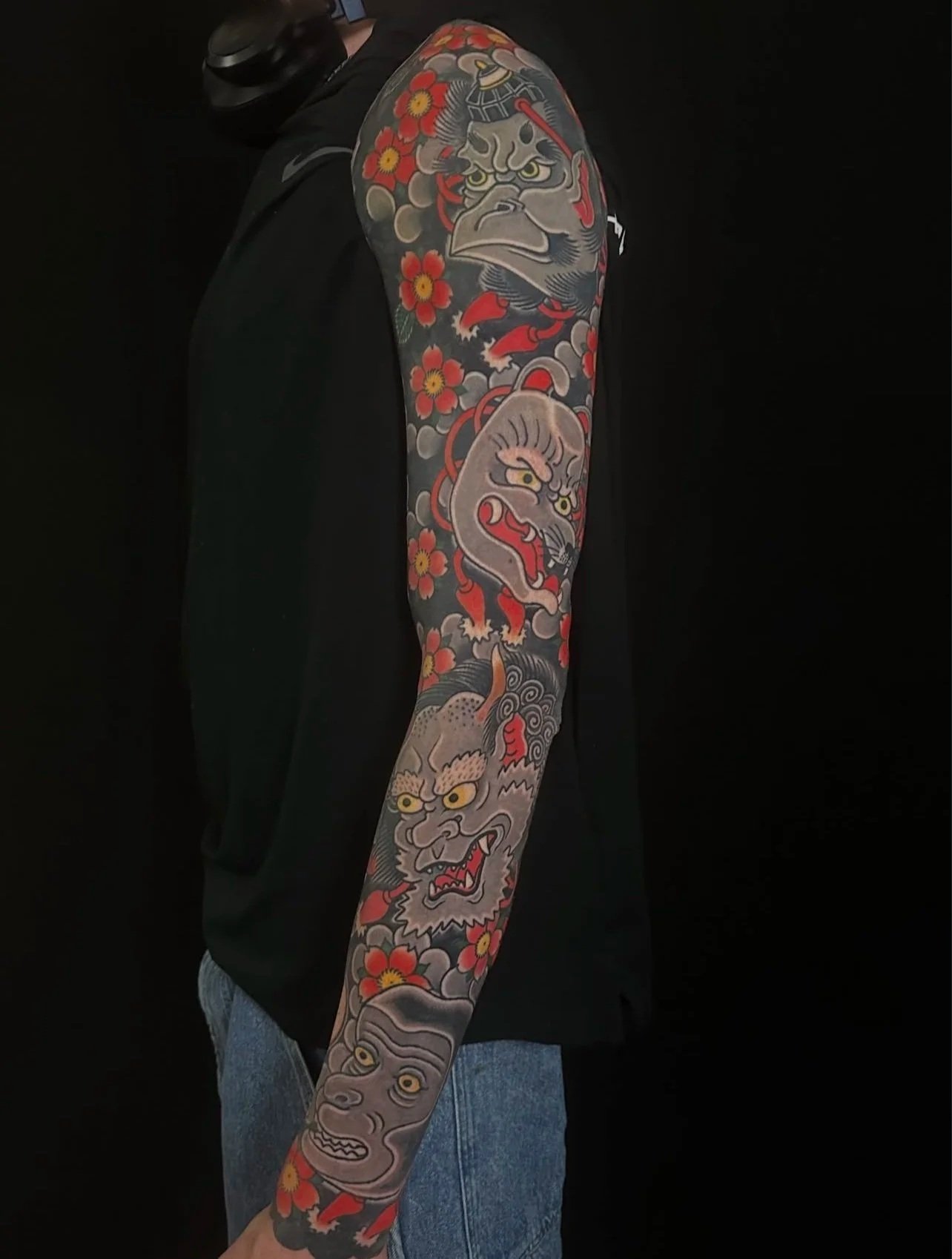BLOG
Japanese mask arm sleeve by TomTom
In Japanese Irezumi, placement shapes meaning, and a sleeve arranged from Tengu at the top to Saru at the wrist creates a flowing descent through different layers of myth. With sakura blossoms drifting through the background, the entire piece gains a sense of impermanence, beauty, and seasonal renewal.
The sleeve opens with the Tengu on the upper arm or shoulder, the mountain spirit known for discipline, martial skill, and watchful protection. Perched above the other masks, it acts as a guardian looking down over the design. Its bold features set the tone against a scattering of soft cherry petals.
Below it sits the Kitsune, the shapeshifting fox spirit whose intelligence and mystery bridge the realms of illusion and clarity. The delicate forms of falling sakura emphasise the Kitsune’s elegance and create a smooth transition between the upper and middle sections of the arm.
Moving onto the lower arm lies the Oni, fierce yet protective. The cherry blossoms around it soften its intensity without diminishing its power, illustrating the balance between inner turmoil and the beauty found in confronting it.
The sleeve concludes with the Saru near the wrist, the playful monkey spirit symbolising cleverness and adaptability. As petals swirl around the mask, the energy becomes lighter, grounding the design in movement and human warmth.
Together, the Tengu, Kitsune, Oni, and Saru, woven through drifting sakura; create a unified story of vigilance, transformation, strength, and spirited resilience.
Native Birds by Veronica
New Zealand’s native birds are perfect for fine line tattoos; delicate, elegant, and full of character. Veronica’s designs capture their natural forms with clean lines and subtle detail, whether it’s a standalone bird or combined with florals, ferns, and other native elements.
Each bird carries its own meaning: the pīwakawaka (fantail) brings curiosity and adaptability, the tui represents expression and individuality, the pūkeko embodies confidence, the kiwi stands for quiet strength, and the kōtare (kingfisher) reflects patience and focus.
Her tattoos can be small and minimalist or part of a larger composition celebrating Aotearoa’s nature. By combining birds with native plants or subtle natural motifs, Veronica creates designs that feel both personal and distinctly New Zealand—perfect for anyone looking for a piece that’s meaningful, elegant, and timeless.
Tako and Fugu sleeve by Horiyama
Japanese tattoos, Irezumi, are known for their deep symbolism and bold, flowing designs. A sleeve featuring an octopus and puffer fish is not only visually striking but also rich in meaning, blending intelligence, mystery, and hidden strength.
The octopus (tako) in Japanese tattoo art represents intelligence, adaptability, and the ability to escape danger. Its tentacles add movement and flow to a sleeve design, wrapping naturally around the arm. In folklore, it also embodies transformation and trickery, ideal for someone who values wit and flexibility.
The puffer fish (fugu) offers a playful contrast. Often seen as a symbol of duality and inner strength, it may look harmless but is highly toxic—a reminder that appearances can be deceiving. It’s a fitting emblem for those who present a calm exterior while hiding resilience or risk-taking underneath.
Together, the octopus and puffer fish create a balance of cunning and caution, movement and tension. Surrounded by traditional elements like waves, wind bars, and coral, they form a sleeve that tells a deeply personal story—one of survival, strength, and the mystery of the sea.
Tiger and Sakura Sleeves by TomTom
Tom Tom recently completed these two arm sleeves for Nami, each featuring sakura (cherry blossoms), adding in a tiger as the main element on the second sleeve.
One sleeve focuses entirely on sakura as the central element. Traditionally symbolising the fleeting nature of life, the cherry blossoms are arranged to follow the natural lines of the arm, creating a cohesive and balanced flow.
Tom Tom uses rich reds, yellows, and greens in the blossoms and leaves, adding vibrancy to the otherwise black and grey foundation. The color work brings energy and visual contrast, while still respecting the traditional aesthetic. Negative space and soft shading help keep the design clean and structured.
The second sleeve introduces a more dynamic composition, pairing a detailed tiger with the softness of sakura. The tiger, rendered with strength and movement, acts as the focal point—symbolising power and protection.
The sakura here serves as both a visual and thematic counterbalance. Just like in the first piece, bold reds, yellows, and greens are used in the blossoms and foliage, giving the sleeve a vivid, layered appearance. The color adds contrast to the tiger’s black and grey tones, enhancing depth without overwhelming the piece.
Classic Dragon and Sakura Sleeve by TomTom
In traditional Japanese tattooing; known as irezumi, the combination of the dragon and sakura is both visually powerful and deeply symbolic. When used together in a full arm sleeve, these two elements represent a balance of strength and impermanence, drawing from centuries of cultural meaning and mythological roots.
The Japanese dragon (ryū) has long been a symbol of strength, wisdom, and protection. Unlike the dragons of Western folklore, Japanese dragons are typically benevolent, associated with water and the heavens rather than destruction. In tattoo art, they often appear as long, serpentine creatures with flowing whiskers and clawed limbs. A dragon sleeve represents control over chaos, spiritual power, and personal growth. It’s also linked to ancient beliefs that dragons were guardians of natural forces, especially rain and rivers—essential elements for life.
The sakura, or cherry blossom, carries a different message. In Japanese culture, the blossom's brief life is a reminder of the fleeting nature of existence. Rooted in Buddhist philosophy and embraced by samurai ideals, sakura symbolize both the beauty and fragility of life. In tattoos, they serve as a counterbalance to more dominant figures like dragons or tigers, introducing a sense of transience, humility, and reflection.
When combined in a single sleeve, the dragon and sakura create a powerful visual contrast—strength and softness, permanence and impermanence. The dragon may wrap around the arm in bold, dynamic lines, while the sakura petals fall gently around it, often used to fill background space or emphasize motion.















